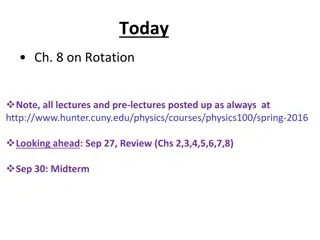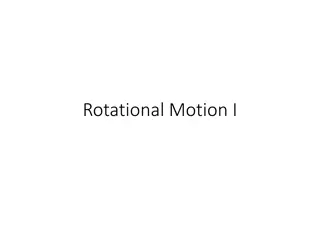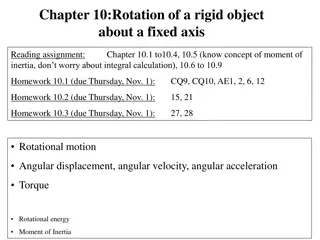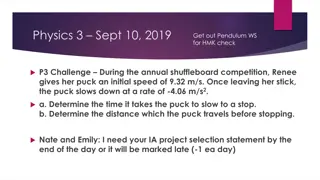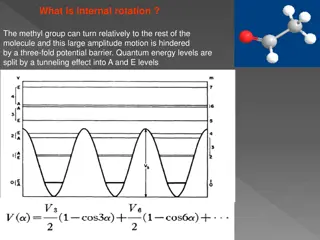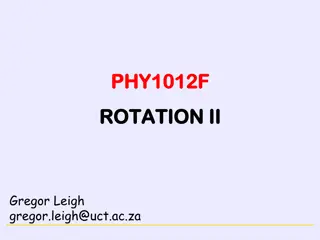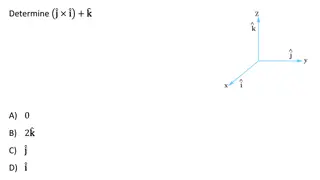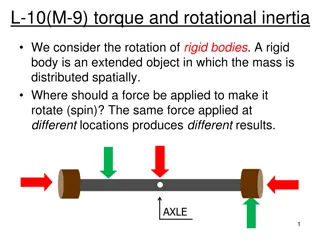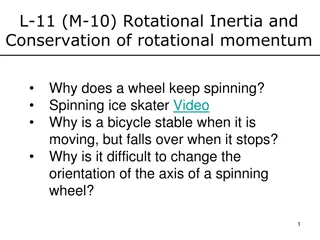Understanding Rotational Dynamics in Physics
General announcements for a physics class covering topics on rigid bodies, torque, moment of inertia, and rotational Newton's second law. Learn about the importance of moment of inertia, calculating rotational inertia, and the application of Rotational N2L in problem-solving exercises. Explore the relationship between mass distribution and rotational acceleration, as well as the concept of torque in determining angular acceleration. Gain insights into lab activities and prepare for upcoming quizzes on rotational motion.
Download Presentation

Please find below an Image/Link to download the presentation.
The content on the website is provided AS IS for your information and personal use only. It may not be sold, licensed, or shared on other websites without obtaining consent from the author. Download presentation by click this link. If you encounter any issues during the download, it is possible that the publisher has removed the file from their server.
E N D
Presentation Transcript
General announcements Turn in Rigid Body Lab Today: Quiz 2 on rigid bodies/torque Rotational N2L and practice problems Next quiz will be on Thursday and cover moment of inertia and rotational N2L problems Today and tomorrow, we ll look at the possible quiz questions and how to solve them, then turn our attention to energy considerations Final 2 quizzes of this unit are on Tuesday and Thursday of next week
Reminders about moment of inertia The moment of inertia is the rotational counterpart to mass. Mass is a measure of inertia: more mass means more resistance to acceleration. For a rotation, the distribution of that mass about the axis of rotation is what matters in terms of resisting angular acceleration One object has a given mass that doesn t change. But its moment of inertia may be different about different rotational axes (e.g. about one end vs. through center of mass) When mass is farther from the axis of rotation, the moment of inertia increases. Solid disk vs a hoop with the same mass: which has greater I? This means the disk will angularly accelerate more quickly for the same applied torque. The hoop: the mass is concentrated farther out from the axis of rotation (through the center of the disk/hoop). (For your information, Ihoop = MR2 whereas Idisk = MR2)
Things you need to know about I Every object has a moment of inertia expression that allows you to determine its rotational inertia about a particular axis. A greater moment of inertia means it s harder to change the rotation of the object (just like more mass means harder to accelerate an object). These expressions can be derived using calculus. This is not something you will be tested on. You should know that the general form for moment of inertia for a point mass is mr2 (where r is the distance between the axis of rotation and the location of the point mass) If there are multiple point masses, you just sum their individual I. For more complicated shapes, you ll be given the I for that shape (or given everything else and asked to find it). If you know the moment of inertia about one axis and need to know it about a parallel axis, use the Parallel Axis Theorem: ?????????= ???+ ??2
Rotational N2L in its full form Putting it all together, we now can say: ? = ?? In words: the angular acceleration of an object depends on the net torque about the axis of rotation and the moment of inertia of that object about that same axis. Technically, torque and angular acceleration are vectors, so a direction is required. However, for all our problems, the plane of rotation will be in the page, so the unit vector will be assumed to be ?. We won t need to write that for these problems, but we will need to keep track of positive and negative signs to indicate the direction of rotation.
Our lab problem - with a twist! (literally..) You ve done a problem in which the tension keeps the rigid body stationary (your lab!). What is the angular acceleration of the beam if the rope is cut, and what is the translational acceleration of a point at the end of the beam?? You may assume the moment of inertia about the beam s center of mass is (we re leaving off the hanging mass to simplify this) 12ML2. 1 T f q
FBD and concepts Last time, all the torques were balanced as the tension force held the beam steady. Now, when the rope is cut, the beam will start to fall down and rotate clockwise. L V H and V are once again through the axis of rotation, so they do not produce a torque. We have two forces that do, so let s sum the torques: mbeamg q H ? = ??+ ?? + ???? ? 2???? = 0 + 0 ??????
N2L To find the angular acceleration, we need I. We know I about the center of mass of the beam, but we need it about one end (where the axis of rotation is). Using the Parallel Axis Theorem: 1 + (?????)(? ????= ???+ ??2= 12??????2 2)2 Remember that d in this equation is the distance between the axis through the center of mass and the axis through the point you are interested in, which in this case is the axis through the pin. That is why d = L/2 in this problem Now we can use N2L: ? = ?? ? 2???? ?????? = (1 3??????2)?
Solving Now we just rearrange for angular acceleration: ?????(? 1 3??????2 2?????) = 3????? 2? ? = From our translational/rotational relationships, we know that ??= ??. Given that the end of the beam is a distance L from the axis of rotation, its acceleration would just be L times that whole mess up above, or: ? = 3????? ? = 3 2????? 2?
Ball rolling down an incline Determine the acceleration of the ball as it rolls down the incline. Assume you know the incline s angle, the ball s mass and radius, and assume its moment of inertia about its central axis is I =2 5mR2 How does a ball roll? Something must be required to allow it to rotate about the point of contact that means keeping the point of contact motionless as the ball rotates around it. What could do that? q
Ball rolling down an incline y For the acceleration of the center of mass, the translational version of N.S.L: x -mg sinq + f = -ma Fx: mg Ffs N For the angular acceleration about the center of mass, the rotational version of N.S.L: ???: q (f)(R) = Icma Gcm: 2mR2 5 a R (f)(R) = 2m 5 a ( ) (f) =
Ball rolling down an incline Combining, we get: -mg sinq + f = - ma - mg sinq + 2 5ma = - ma mg sinq = 7 5ma a = 5 7g sinq But wait! There s another way! What if we found the angular acceleration about the contact point?
Balling rolling down incline (mg)(R sinq) = Ipa ??: Gp: y x To finish this off, we need to know the moment of inertia about the contact point p, and the relationship between the acceleration of the center of mass and the angular acceleration of the ball about the contact point. r q Ip= Icm+md2 f mg Ip= Icm+ md2 =2 5mR2+ mR2 =7 5mR2 r^= Rsinq N r^ Note: is the shortest distance between the line of force and point about which torque is being taken . . .
Ball rolling down incline With the moment of inertia of the parallel axis theorem and the known relationship between the angular acceleration and the acceleration of the center of mass, we can write: (mg)(R sinq) = Ipa ??: Gp: 7 5mR2 a R (mg)(R sinq) = a = 5 ? =5 7mg sinq 7????? We get the exact same answer. Which makes sense because no matter what the axis of rotation, the angular acceleration of the object is the same.
Atwood machine problem A mass m1 is attached to a rope that is threaded over a massive pulley and attached to a second mass m2. If the pulley s mass is M, its radius R and its moment of inertia about its center of mass is 0.5MR2, determine both the angular acceleration of the pulley and the acceleration of each of the masses. To start: think about what assumptions we made in the past in order to do this problem. Why did we do that? Can we still make those assumptions now?
To get a feel for the intricacies of this problem, let s do it first on the assumption the the pulley is NOT massive. In that case, Newton s Second Law applied to each mass and we can write: f.b.d. on m1 : So:
f.b.d. on m2 : So: Notice that we are able to assume the tension on both sides of the pulley is the same. This is the consequence of the fact that the pulley is assumed to be massless. If that hadn t been the case, a net torque would have been required to make the pulley rotate. That could only come if the tension forces on either side of the pulley were imbalanced. From the previous page, so we can write: g
Now lets look at the situation assuming the pulley is massive. In that case, the only difference is that the tensions are different on either side of the pulley (this has to be so so the torque sum about the pulley s center of mass is not zero). Writing, we get: f.b.d. on m1 : So:
f.b.d. on m : So: At this point, we have three unknowns, the two tensions and the acceleration a. We need another equation. ENTER SUMMING THE TORQUES ABOUT THE PULLEY S CENTER OF MASS.
f.b.d. on pulley: Has to be negative because it s rotating clockwise! So: ???: At this point, we have FOUR unknowns, the two tensions, the acceleration a and the angular acceleration ?. Once again, we need another equation. That relationship connects the angular acceleration about the pulley s center of mass to the translational acceleration of a point on the pulley s edge (this will be the same as the translational acceleration of the string and, hence, the masses). In other words, we need:
We now have four equations: Equ. A Equ. B Equ. C Equ. D Substituting Equ. A, B and D into C, we get: 2 Note that with the exception of the presence of the M term, this is exactly the same relationship you got with the massless pulley analysis.



